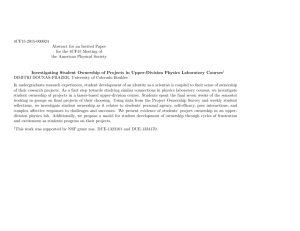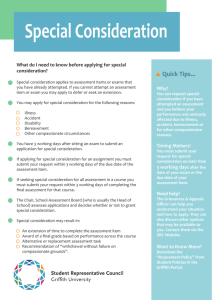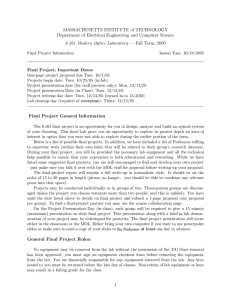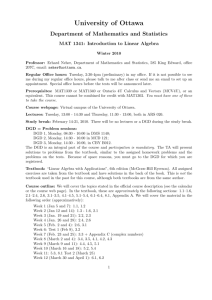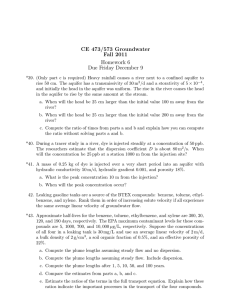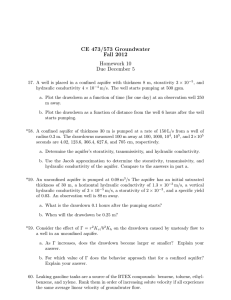Design I-A Fall 2012, Art 081 231 Rutgers University Mason Gross
advertisement
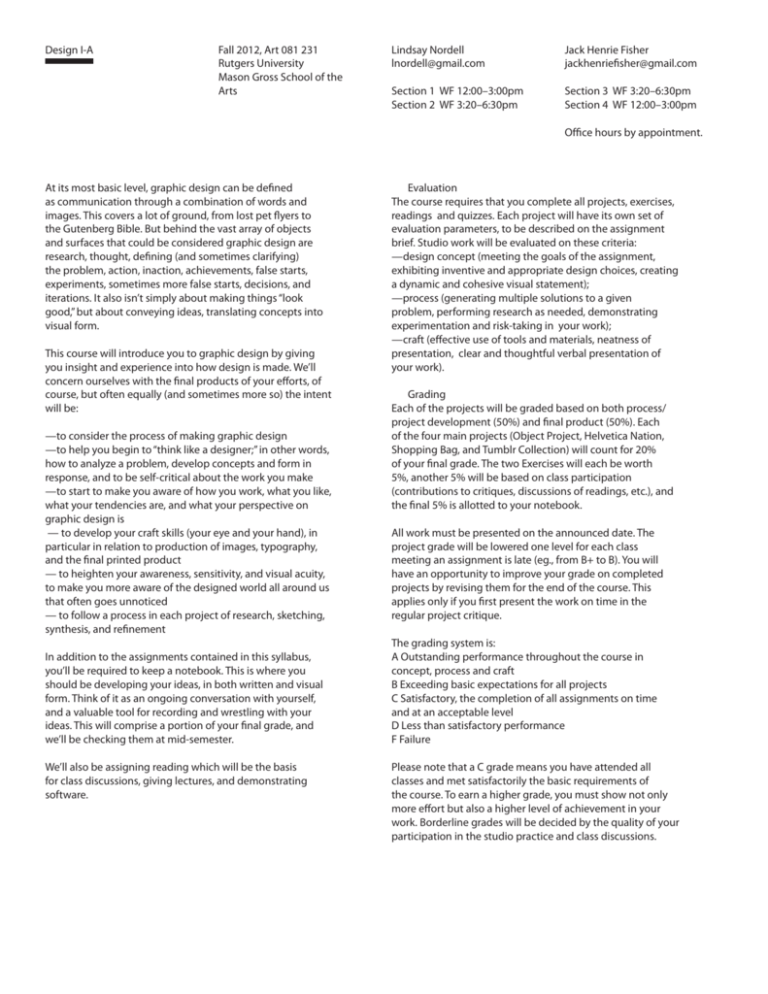
Design I-A Fall 2012, Art 081 231 Rutgers University Mason Gross School of the Arts Lindsay Nordell lnordell@gmail.com Jack Henrie Fisher jackhenriefisher@gmail.com Section 1 WF 12:00–3:00pm Section 2 WF 3:20–6:30pm Section 3 WF 3:20–6:30pm Section 4 WF 12:00–3:00pm Office hours by appointment. At its most basic level, graphic design can be defined as communication through a combination of words and images. This covers a lot of ground, from lost pet flyers to the Gutenberg Bible. But behind the vast array of objects and surfaces that could be considered graphic design are research, thought, defining (and sometimes clarifying) the problem, action, inaction, achievements, false starts, experiments, sometimes more false starts, decisions, and iterations. It also isn’t simply about making things “look good,” but about conveying ideas, translating concepts into visual form. This course will introduce you to graphic design by giving you insight and experience into how design is made. We’ll concern ourselves with the final products of your efforts, of course, but often equally (and sometimes more so) the intent will be: —to consider the process of making graphic design —to help you begin to “think like a designer;” in other words, how to analyze a problem, develop concepts and form in response, and to be self-critical about the work you make —to start to make you aware of how you work, what you like, what your tendencies are, and what your perspective on graphic design is — to develop your craft skills (your eye and your hand), in particular in relation to production of images, typography, and the final printed product — to heighten your awareness, sensitivity, and visual acuity, to make you more aware of the designed world all around us that often goes unnoticed — to follow a process in each project of research, sketching, synthesis, and refinement In addition to the assignments contained in this syllabus, you’ll be required to keep a notebook. This is where you should be developing your ideas, in both written and visual form. Think of it as an ongoing conversation with yourself, and a valuable tool for recording and wrestling with your ideas. This will comprise a portion of your final grade, and we’ll be checking them at mid-semester. We’ll also be assigning reading which will be the basis for class discussions, giving lectures, and demonstrating software. Evaluation The course requires that you complete all projects, exercises, readings and quizzes. Each project will have its own set of evaluation parameters, to be described on the assignment brief. Studio work will be evaluated on these criteria: —design concept (meeting the goals of the assignment, exhibiting inventive and appropriate design choices, creating a dynamic and cohesive visual statement); —process (generating multiple solutions to a given problem, performing research as needed, demonstrating experimentation and risk-taking in your work); —craft (effective use of tools and materials, neatness of presentation, clear and thoughtful verbal presentation of your work). Grading Each of the projects will be graded based on both process/ project development (50%) and final product (50%). Each of the four main projects (Object Project, Helvetica Nation, Shopping Bag, and Tumblr Collection) will count for 20% of your final grade. The two Exercises will each be worth 5%, another 5% will be based on class participation (contributions to critiques, discussions of readings, etc.), and the final 5% is allotted to your notebook. All work must be presented on the announced date. The project grade will be lowered one level for each class meeting an assignment is late (eg., from B+ to B). You will have an opportunity to improve your grade on completed projects by revising them for the end of the course. This applies only if you first present the work on time in the regular project critique. The grading system is: A Outstanding performance throughout the course in concept, process and craft B Exceeding basic expectations for all projects C Satisfactory, the completion of all assignments on time and at an acceptable level D Less than satisfactory performance F Failure Please note that a C grade means you have attended all classes and met satisfactorily the basic requirements of the course. To earn a higher grade, you must show not only more effort but also a higher level of achievement in your work. Borderline grades will be decided by the quality of your participation in the studio practice and class discussions. Design I-A, continued Late work/revisions You can revise projects at any point in the semester, and the final grade will be an average of the new grade and the old grade. However, you must turn in a final project on the day it’s due, even if you plan on revising later. Late work will lower your grade by one level (A to B+, C+ to C, etc.) for each day the work is late. Attendance Students are expected to attend all classes; it’s crucial for the success of the course that you come to class and do so on time. However, if you expect to miss one or two classes, please use the University absence reporting website https:// sims.rutgers.edu/ssra/ to indicate the date and reason for your absence. An email is automatically sent to me. In the event of an absence, you will be responsible for making up any missed work and finding out what’s expected for the next class. You are allowed three unexcused absences. Your fourth absence will lower your final course grade one level, and each subsequent absence will lower your grade another level. Three arrivals of more than 10 minutes late will count as an unexcused absence. No cell phone use in the classroom or lab. No instant messaging or Facebooking during class time. Supplies —Notebook/sketchbook (11”×14”; should be a drawing sketchbook, not lined notebook paper) —Pencils/colored pencils/pens —X-Acto knife and replacement blades —Scissors —Metal ruler, at least 18” —Illustration board (for Object Project) —Spray mount —Burnisher (for mounting) —Digital camera (not your cell phone—needs to be capable of producing pictures that are high enough in resolution to print well. You can also borrow one from the lab.) —Some sort of external storage device (hard drive, flash drive, CD, etc.) for backing up your work. Exercise #1 Graphic Design is ... For this first exercise, read the introduction to Richard Hollis’ Graphic Design: A Concise History as well as the short essay “About the Word Design” by Vilém Flusser. Then, using whatever means you have, modify an 8 1/2”×11” sheet of paper to communicate your idea of what Graphic Design ‘is’. Your modifications can take the form of marks (printing, drawing, painting), assemblage/collage, or even alterations to the paper itself (folding, cutting). Present your sheet to the class in order to explain and/or defend your idea. Schedule Wednesday, September 5 Class introduction Friday, September 7 Bring your completed sheet, ready to discuss.
